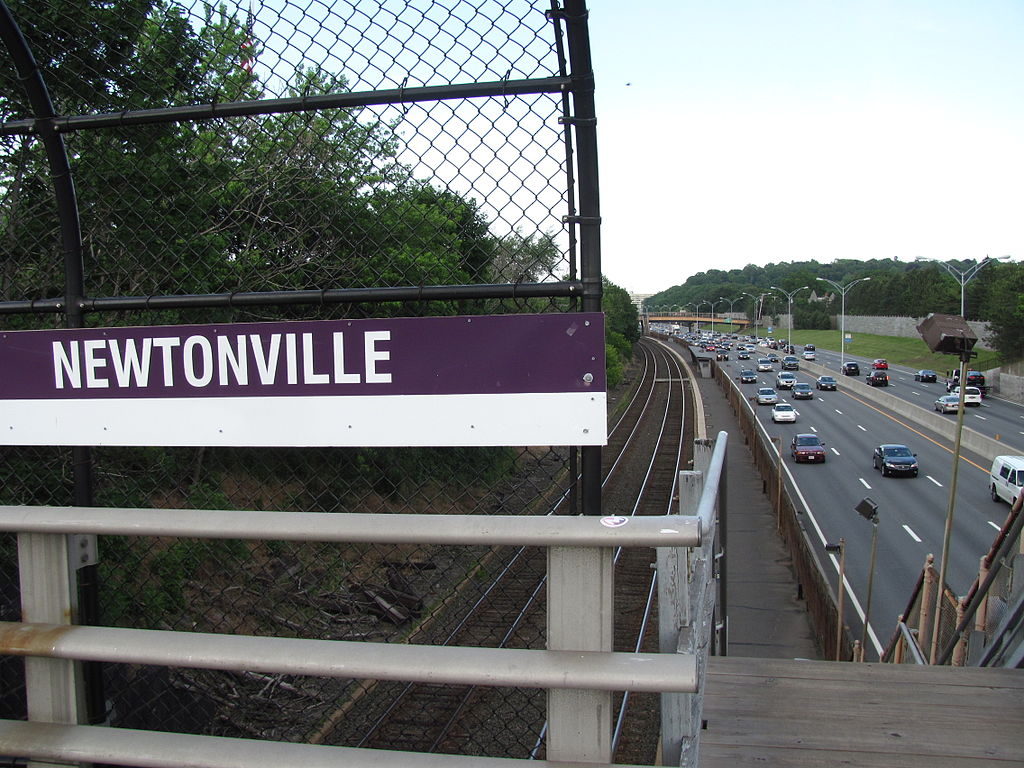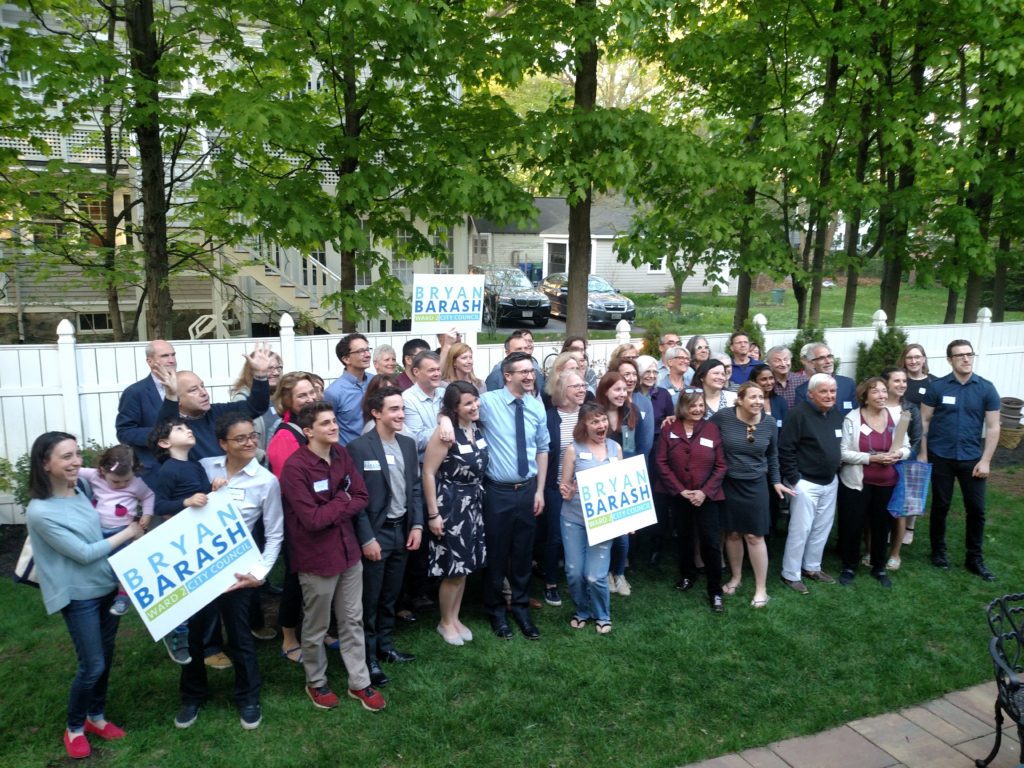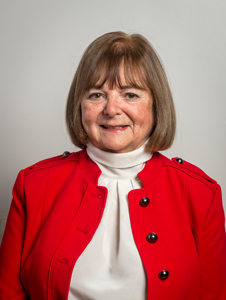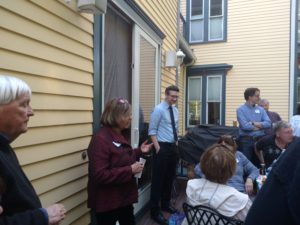The Trans-Commonwealth RR: Newton Service So Close… & yet So Far Away…
The Trans-Commonwealth Railroad is a series on the challenges and efforts to connect the length of Massachusetts by rail.
NEWTON—The same highway and rail line that divide Boston also splits Newton. In the capital city, the corridor separates neighborhoods from each other. Here, it pierces several of this city’s villages. Frothing traffic spills out into veins of streets, branching outward from the Turnpike. The Worcester Line tracks and dismal stations along I-90 provide little relief.
Substandard commuter rail bleeds into housing, environmental, accessibility and quality of life. Advocates have demanded upgrades for years and municipal candidates have begun to take heed. Yet, this length of track is only part of the larger ex-Boston & Albany Railroad. Investment is in demand throughout its length. If realized, it could transform Massachusetts, but perhaps only if the route is considered a coherent whole.
From the 413, East-West rail is easily seen in isolation—a critical link between the commonwealth’s capital and its occident. That proposed service does not exists in a vacuum. Understanding the route’s many needs and how they fit together is essential to realizing any improvements.

Newtonville is a mix of historic homes and… (via Wikipedia)
Newton’s Ward 2, centered on the village of Newtonville, stands to gain—or lose—a lot depending on whether and when these investments happen. It has a station, but as with the other Newtonian stops—Auburndale and West Newton—service is almost comically inadequate.
Officials like Representative Kay Khan have doggedly sought change. Some pols dryly note Massachusetts Secretary of Transportation Stephanie Pollack lives in Ward 2. That has not prompted swift action, but rail is now affecting local races.
Some Will Win, Some Will Lose

…and a more urbanized village center adjacent to its eponymous rail station. (via Wikipedia)
Both Ward 2 City Council candidates, the incumbent Emily Norton and challenger Bryan Barash, support rail investment. They differ on style and rail’s relations to other issues in town.
If an inflection point exists between Barash and Norton’s race, it is subtle. Both appear to be solidly liberal and environmentally-minded. Barash, a 2008 campaign staffer for Barack Obama, is chief counsel to Senate President Emerita, Harriett Chandler. Norton, executive director of the Charles River Watershed Association, once led the Sierra Club in the state.
They differ on development. The grade crossing with commuter rail lies at whether Newton needs to commit to more housing, i.e. denser development in the built-out city.
“We are as close to Boston as it gets,” Barash said. “That only works if the housing is there.”
To Barash, that means that state rail investment here, at least under this governor, may only come if Newton commits more fervently to transit-oriented development (TOD). That could mean more apartments clustering around Newtonville station—as there once were above nearby retail buildings— in addition to commuter lots and bikes.
Norton, while supportive of increased commuter rail, worries about the housing impact.
“I think upgrades to our commuter rail may actually make housing more expensive if it increases demand for housing nearby, which is a dynamic we have seen happen in other communities when the public transportation improves,” she said in an email.
The Midnight Train
Of the B&A’s 162 miles in Massachusetts—now split between CSX and the Massachusetts Bay Transit Authority (MBTA)—only about five are in Newton. Although lined with three stations, the city’s stretch of track is grossly underutilized.

Then–circa 1907-1915 (via Wikipedia)
The stations, originally key to this suburb’s original bloom, got the heave-ho when the Pike plowed through. Highway engineers discarded rail flexibility along with lovely original stations.
West Newton, Auburndale and Newtonville stations were rebuilt with a single platform, inaccessible to the mobility-impaired, on the inbound track. Outbound trains that stop here must cross to the inbound track. Aside from the two-track Worcester Line’s terminal in that city, no other station serves only one track. That limits inbound traffic, too, leaving the MetroWest community closest to Boston with pitiful rail service.

…and 100 years later. (via Wikipedia)
Express bus service helps, but traffic at rush hour or Red Sox gamedays prove it is hardly enough.
Home to two of the commonwealth’s major east-west roads—the other being Route 9—Newton is no stranger to traffic issues. Those interviewed for this article note efforts to solve congestion go back decades.
“I’m hopeful we’ll be moving along and doing something soon,” Khan said of rail in Newton. In an interview, she described the years-long slog to make progress, but remained bullish about the potential.

State Rep Kay Khan (via Twitter/@repkaykhan)
“All three station are in a village,” of Newton’s, she said. “They’re really prime areas for transit-oriented development.”
Khan traces the shift to then-Governor Deval Patrick. His administration purchased the B&A between Framingham and Worcester. That purchase opened space to reassess Newton’s commuter rail service. Meanwhile, lawmakers finally folded the Turnpike Authority—which owned the tracks between Boston and Framingham—into the Massachusetts Department of Transportation (MassDOT).
As a commuter service, the Worcester Line runs from its namesake city to Boston’s South Station.
Khan noted a recent attempt to upgrade Auburndale, the Newton station farthest from Boston. The project would have built a new, handicap accessible platform on the north side of the tracks, replacing the one wedged between the tracks and the Pike.
Living Just to Find Motion
The plan faltered amid objections from TransitMatters, a pro-transit group. In February 2017, TransitMatters Civic Outreach Director Andy Monat savaged the proposal in Commonwealth Magazine. Moving Auburndale’s platform, he wrote, would worsen the operational inflexibility the Newton stations already experience with the current single-platform stations.
Ari Ofsevit, the Technical Advocacy Director for TransitMatters, defended his group’s intervention. In an email, he acknowledged the move derailed the original Auburndale-only project. As designed, however, it did not take operations into consideration and would have smothered rush hour service.

Auburndale Station in 2012. The original plan would have built a handicap accessible platform on the other side of the tracks…but trains would have to cross over to reach the other Newton stations. (via Wikipedia)
“It was very clear that a serious mistake had been made; within a week of the public meeting the T had realized their error and gone back to the drawing board,” Ofsevit said.
As far as his group’s late intervention, Ofsevit said no hearings had happened between 2013 and 2017.
“Members of [TransitMatters], including myself, were present at the 2017 meetings and subsequently, but there had not been a meeting for the four years prior,” he said.
What happens long-term is not clear, but the new iteration of the project will put new, high-level platforms at all three stations.
A MassDOT spokesperson confirmed three designs came back after the Auburndale-only project was scrapped. All three stations will undergo rebuilding under current plans.
The first design would install a single new, high-level platform at all three stations. Another would build a second platform to provide service on both sides. A third proposal, the most expensive, would construct island platforms to serve both tracks. Island platforms require fewer elevators, it would almost certainly necessitate track relocation.
MassDOT did not confirm whether the single-platform option could lead to a second side platforms. Khan suggested it could. In any event, however, officials have not identified funds for the project.
City officials will have to deal with the fallout—and perhaps play a role in advocating for the project. But how?
The Movie Never Ends?
On May 11, Barash formally kicked off his campaign at a private home on a Newtonville side street of elegant, but tightly clustered single-family homes. The candidate himself addressed supporters on a side yard wedged in between the house and the fence.
In his remarks, among issues at least partially related to commuter rail were housing, the environment and traffic.
“Local government can make a big impact on the issues we care about,” he told supporters.
Bespectacled and wiry, Barash, 35, projects both a policy wonk vibe and the fading air of a punk rock musician. Flecks of grey salt the sides of his otherwise black helmet of hair while near-invisible gauges rest in his ears.
In an interview as his kickoff party wound down, Barash said city officials have to assert a role in the process of bringing in better service and developing a larger transportation. With the ward split by the Pike and B&A, the traffic and congestion are huge issues and his pitch includes leveraging his experience with state government.
“Councilors are a part of those conversations,” he said. “The key is having a councilor who is willing to say [to state officials] ‘we can work with you.’”
In this literal sense, there is less daylight between Barash and Norton. Norton said councilors must act as advocates.
“I have had my small victories,” she emailed. She said she had persuaded the MBTA to clean up station litter and replace trees—“that had provided green cover from the ugly chain link fence next to the train tracks.” They had been cut down for a fiber-optic project.
A chicken and egg problem confront Newton rail improvements. Structurally, better service is difficult with one platform. However, faster boarding with high-level platforms could facilitate more service.
“Service in Newton is horrible,” Susan Albright, an at-large councilor from Ward 2 told WMassP&I at Barash’s event. She wasn’t too keen on the original Auburndale plan either, but acknowledged the $100 million price tag for installing two platforms at all three stations.
Albright, who chairs the Zoning & Planning Committee, pointed to congestion along Washington Street. The four-lane road hugs the Pike and consequently carries its overflow. That makes the street more dangerous for pedestrians and complicates the installation of bike lanes and traffic calming measures.
With some exceptions, encouraging developers to build multi-unit TOD is difficult without service already there. Plus swaths of Newton are not near any stations. But some developers are willing to innovate.
“In the early 1900s, they”—developers of the day—“started streetcar service,” to connect workers to new housing, Albright said.
She said some builders have considered running shuttles between their projects and existing transit like the MBTA’s Green Line D service. If commuter rail improved, similar connections might be possible.
Going Anywhere?
Although it has a reputation for wealth, Newton’s socioeconomic strata defy the stereotype. Areas north of the Pike are not as well-off as those to the south, which developed later with many more large homes.
As with Boston, the Newton’s transportation options limit the city and residents. Wedged, both physically and developmentally, between the Hub and suburbia, it faces a reckoning.
Barash, the Ward 2 candidate, said the poor alternatives to driving have an impact. They restrict commuting options, especially, west to Worcester and could discourage new residents from moving here.
All of that could threaten the city, its residents and its tax base long term. Broadening its residents commuting options and linking Newton to workers and visitors from anywhere along the B&A is part of the solution.
“I am someone who is open to working with the rest of the state” on this, Barash said. Cooperation and interconnectedness, he continued, “has to be part of the conversation.”




